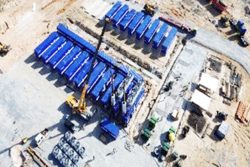The Guyana Energy Agency (GEA) has gazetted an application for a Hydro-Electric Power Licence made by the Hinterland Electrification Company Inc/Mabaruma Power Company.
The application, first made on May 11th, 2017, identifies Hosororo Creek in Region One as the source of supply and notes that the intention is to construct and operate a 20kW hydropower facility at Hosororo, Region One and supply the energy generated to the Mabaruma Power Company.
The L-shape reinforced concrete weir, with coordinates 8°10.113’ N, 59° 48.456’ W, is identified as the place designed to be the area of diversion at the Hosororo Creek.
According to the gazette’s notice, any person may within 21 days of the first publication, lodge with the Chief Executive Officer of the GEA, a petition to the Minister objecting to the grant of the Licence.
This notice comes one year after government announced that works on the Hosororo plant would begin in July, 2017 and be completed by March, 2018.
A May, 2017 statement from the Department of Public Information (DPI) noted that as part of its mandate to develop and encourage the development and utilisation of new sources of energy the Guyana Energy Agency (GEA) Engineers with assistance from GIZ/REETA (German Society for International Cooperation/ Renewable Energy and Energy Efficiency Technical Assistance) completed the feasibility study, design and bid documents for redevelopment of a defunct micro hydropower plant at Hosororo.
It explained that the main objectives of the project were to increase the energy mix of the Mabaruma electrical grid with a clean and renewable source of energy; to gain experience in applying hydropower engineering and other multi-disciplinary concepts for sustainable rural electrification; to gain understanding of run-of-the-river hydro technology and to promote and increase the use of renewable energy in Guyana.
In 1985, a study done by Terrence Fletcher and Associates Limited studied the option to install a hydropower plant at the creek and supply electricity to an agricultural produce processing facility to be built nearby. Later, in the late 1980s, a powerhouse with a turbine of reportedly 5 kW capacity was installed using the upper of two existing concrete weirs but the project was abandoned some years after its inauguration for reasons that are still unclear. The DPI said then that the Mabaruma Power and Light Company Inc. supplied power to about 735 households with generators supplying about 400kW peak load, while the Hinterland Electrification Company Inc was in the process of procuring and installing a 400kW solar photovoltaic farm. The hydropower plant will only be supplying about 20kW towards meeting the demand of the community.
“The plant, conceptualised by GEA’s Engineers, will entail the construction of a 20kW run-of-the-river type micro hydropower plant inclusive of weir/intake, penstock and power house. Electricity from the new plant will be fed directly to the distribution network of the local power utility MPLCI and will provide about 8% of the annual energy demand of 735MWh. The power system incorporating diesel, solar and hydro would be the first hybrid system of such diversity providing energy in Guyana. The computed Levelised Cost of Energy (LCOE) was USD 0.31 per kWh compared to the cost of generation from fossil-based diesel of about USD 0.50 per kWh,” the statement said.









